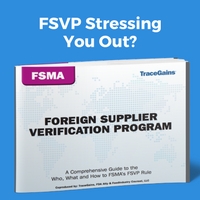The food we eat is a lot less secure than we would like to imagine. According to PricewaterhouseCoopers, food fraud is estimated to be a $40 billion a year problem, with instances of fraud becoming worryingly frequent—from wood shavings discovered in our parmesan to the 2013 horsemeat scandal in the UK.1-3 Not only do these incidents damage the faith consumers have in their food, but as seen in the 2009 salmonella peanut butter outbreak, which resulted in the death of 9 Americans and sickening of 714, they can have fatal consequences.4 Indeed, the World Health Organization estimates that nearly 1 in 10 people become ill every year from eating contaminated food.5
While it may be uncomfortable to imagine our food supply can be susceptible to such high profile attacks, what is more unsettling is that our food supply chain has grown so complex that it has become almost impossible for food producers to guarantee the provenance of their products—meaning consumers can never entirely trust in the food they eat. In this article I will identify five main issues the global food supply chain faces, and what steps can be taken to address them.
Exchange knowledge about managing your supply chain at the Best Practices in Food Safety Supply Chain conference | June 5–6, 2017 | LEARN MORE1. Consumer demand for traceability
Traceability is no longer a request from consumers, but a demand, and one that is only growing stronger. A recent transparency survey found that consumers want to see everything from a complete ingredient breakdown to sourcing information, with 94% of respondents saying they are likely to be more loyal to a brand that offers complete transparency.6 While a new study discovered that more than half of Canadians are concerned about food fraud.7
If we take seafood products as an example, almost half (46%) of respondents to an independent research survey conducted by the Marine Stewardship Council (MSC) agreed that they trust brands that use ecolabels (a form of third-party certification) more than those that do not.8 The survey also found that 66% of respondents felt that traceability of the product was the primary factor determining seafood purchasing decisions.
This kind of consumer driven, high-quality information opens up a world of possibilities for companies that recognize the significance of its demand. Brand protection, demand forecasting and consumer loyalty all becomes possible for early adapters who show themselves to be taking practical steps to guarantee the authenticity of their products.
2. Lack of communication between actors
One of the biggest challenges preventing full traceability of our food is the fragmented nature of the supply chain. For even the most seemingly simple of food items there can be a huge number of actors involved that are spread around the globe with little to no knowledge of one another’s actions.
For instance, to trace your hamburger from farm to fork may involve tracing your lettuce back to the farm in which it was grown (but not what happens to it before it reaches your supermarkets shelves), tracing the beef back to the cattle (with no guarantee, as seen with the horsemeat scandal, that the end product is 100% beef) and any number of logistical barriers.
It is vital then that stakeholders within the chain prioritize communication with their suppliers, either through the implementation of traceability solutions, or the commitment to engage only with suppliers they know they can trust. Not only is this beneficial to the end consumer, but to the food producers themselves, allowing them to ensure that their organizational reputation remains solely their responsibility and not left in the hands of unknown and uncontrollable third parties.
3. Influence of organized crime
When one thinks of the Mafia, it’s rare that olive oil is the first thing that comes to mind. Currently, however, it is the fraudulent manufacture of this and many other Italian exports (cheese, wine, etc.) that is fueling organized crime and ending up on our shelves.9
High-scale food fraud is not a naturally occurring phenomenon but rather exists as a result of highly organized criminal activity. In his 2014 UK government report, Professor Chris Elliot notes that “food fraud becomes food crime when it no longer involves random acts by “rogues” within the food industry, but becomes an organized activity by groups that knowingly set out to deceive and or injure, those purchasing food”.10
This is not just a problem for Italy; counterfeit food and drink occurs on a massive scale throughout the whole of Europe. A joint initiative by EUROPOL and INTERPOL last year led to the largest ever seizure of fake and adulterated projects. This project, known as OPSON V resulted in 11,000 tons and 1,440,000 liters of hazardous fake food and drink seized across 57 countries.11
In order to combat the growing threat organized crime has on our food supply, it is vital that governments devote resources to organizations with the sole responsibility of identifying food crime. In response to the horsemeat scandal, the UK government launched its National Food Crime Unit within the Food Standards Agency in London, while the FDA has a special focus on food defense.
The establishment of these organizations is important, as police forces traditionally have struggled to combat food fraud, either through a lack of time, resources, or simply understanding of the complexities of how fraud affects the supply chain. The creation of specialist taskforces not only legitimizes the fight against food fraud, but allows for easier intelligence share.
4. Lack of transparency throughout the supply chain
In her work on trust for the digital age, Racheal Botsman tells us that trust has evolved from an institutional based system to a distributed system. Nowhere has this more potential than with our food supply.
In such a complex system it becomes necessary to consider how the food industry can begin to move away from traditional systems of centralized trust. As Botsman points out, “institutional trust is not designed for the digital age”, the emergence of new technologies, most notably the blockchain, highlights the potential to introduce more trust in our food.12
Originally the technology underpinning Bitcoin, the blockchain has wide ranging applications beyond the world of FinTech. Blockchain is a transformative tool in the fight against food fraud, allowing an open and transparent ledger of our food products journey. This allows unalterable trust to be introduced into an untrustworthy system, ensuring every actor in the chain records and shares their interactions with our food.
This represents a huge opportunity for those companies who see the advantage of early adoption of blockchain infused traceability systems. Indeed by 2022, Gartner estimates an innovative business built on a blockchain will be worth $10 billion.13
5. Need for strong legislation
Steps have already been made in legislation to allow for earlier prevention of food safety incidents occurring, such as FSMA. While it is important that lawmakers are proactive in their response, the focus has primarily been on food safety, and there is still a difficulty in treating food fraud as its own separate entity.
Legislation regarding food labelling could also be more stringent, especially in Europe. At present only olive oil, fish (unless it’s canned or prepared), beef (fresh, chilled, frozen or minced), fresh or frozen poultry of non-EU origin, wine, most fresh fruit and vegetables, honey and eggs are required to be labelled. This means that origin information is largely missing on foods such as meat products (e.g., ham and sausages), yogurts and cheese, kitchen staples (e.g., oil, flour, sugar and pasta), biscuits and confectionery, or ready-meals.
Tighter legislation, leading to significant punitive measures taken against actors found to be committing fraud, would be a vital catalyst in ensuring that food in our supply chain is as secure as possible.
Conclusion
The growth of the global food supply chain may bring with it complexity and challenges, but also great opportunities. If actors can interject their processes with the kind of joined up thinking outlined above, with the help of technological tools that are becoming more and more accessible, the benefits will be significant, not just for them, but for all of us.
Resources
- PWC. (2016). Fighting $40bn food fraud to protect food supply [Press Release]. Retrieved from http://press.pwc.com/News-releases/fighting–40bn-food-fraud-to-protect-food-supply/s/44fd6210-10f7-46c7-8431-e55983286e22
- Mulvany, L. (February 16, 2016). The Parmesan Cheese You Sprinkle on Your Penne Could Be Wood. Retrieved from https://www.bloomberg.com/news/articles/2016-02-16/the-parmesan-cheese-you-sprinkle-on-your-penne-could-be-wood
- Grierson, J. (August 26, 2016). Three men charged over UK horsemeat scandal. Retrieved from https://www.theguardian.com/uk-news/2016/aug/26/three-men-charged-over-uk-horsemeat-scandal
- Andrews, J. (April 16, 2016). 2009 Peanut Butter Outbreak: Three Years On, Still No Resolution for Some. Retrieved from http://www.foodsafetynews.com/2012/04/2009-peanut-butter-outbreak-three-years-on-still-no-resolution-for-some/#.WD7tE6KLTpJ
- World Health Organization. (2015). WHO’s first ever global estimates of foodborne diseases find children under 5 account for almost one third of deaths [Press Release] Retrieved from http://www.who.int/mediacentre/news/releases/2015/foodborne-disease-estimates/en/
- Label Insight (2016). The 2016 Label Insight Transparency ROI Study. Retrieved from https://www.labelinsight.com/hubf /2016_Transparency_ROI_Study_Label_Insight.pdf?t=1486676060862
- Sagan, A. (February 21, 2017). Study finds 63 per cent of Canadians are concerned about food fraud. Retrieved from http://www.theglobeandmail.com/news/national/study-finds-63-per-cent-of-canadians-are-concerned-about-food-fraud/article34094664/
- MSC (2014). MSC Consumer Survey 2014. Retrieved from https://www.msc.org/newsroom/news/new-research-shows-increasing-appetite-for-sustainable-seafood
Bacchi, U. (February 21, 2017). Italian police break mafia ring exporting fake olive oil to U.S. Retrieved from http://www.reuters.com/article/us-italy-crime-food-idUSKBN1602BD
- HM Government (2015) Elliot Review into Integrity and Assurance of Food Supply Networks. Retrieved from https://www.gov.uk/government/uploads/system/uploads/attachment_data/file/350726/elliot-review-final-report-july2014.pdf
EUROPOL (2016) largest ever seizures of fake food and drink in INTERPOL-EUROPOL operation [Press Release]. Retrieved from https://www.europol.europa.eu/newsroom/news/largest-ever-seizures-of-fake-food-and-drink-in-interpol-europol-operation
- Botsman, R. (October 20, 2015). The Changing Rules of Trust in the Digital Age. Retrieved from https://hbr.org/2015/10/the-changing-rules-of-trust-in-the-digital-age
- Panetta, K. (October 18, 2016) Gartner’s Top 10 Strategic Technology Trends for 2017. Retrieved from http://linkis.com/www.econotimes.com/Zk8mh


























